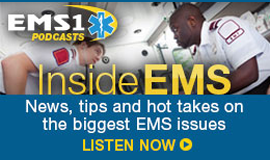You see them at EMS conferences all the time. Invariably, they’re wearing tee shirts with their squad’s logo, or a jumpsuit festooned with merit badge patches, and sometimes they’re wearing their department pager, even though they’re a hundred miles or more from home.
You can spot their cars in the parking lot, because many of them have half the Gall’s catalog bolted to their personal vehicle; $5,000 worth of strobes, flashers, beacons, light sticks, sirens and wig-wags bolted to $1500 worth of car.
And many of us make fun of them for that.
But what many of us never acknowledge is that those volunteers make up the bulk of most conference attendees, by a wide margin. For the most part, they’re paying their own way to get education that will never put a dime in their pocket, and they’re glad to get it.
And while they’re attending, they listen attentively, ask questions, and soak up knowledge from a variety of speakers, each of whom brings their own unique regional or cultural perspective to the table. I’d argue that the breadth of that collective experience dwarfs that of the education and training divisions at many a big-city fire department or EMS agency.
You know who you don’t see many of at these conferences? Paid personnel from major municipal departments, unless they’re recruiting or speaking.
Maybe they don’t need the continuing education hours. Likely as not, their departments provide everything they need. But there is a drawback to having all your training provided in-house. All too often, it becomes an insular, incestuous enterprise dedicated to perpetuating an agency’s organizational culture, and suspicious of new ideas.
Talk to a few of them, and it doesn’t take long to realize that many of them believe that the EMS world as we know it ends at the borders of their response area, and that the sun rises and sets from their chief’s ass.
Those volunteers they view with such derision may not be the most up-to-date clinically, and most don’t have nearly the volume of experience of their big-city paid counterparts, but neither are they jaded and cynical. They still remember why they got into this profession, and they live it every day, taking care of their neighbors in small towns across America.
They remember how to be caregivers.
So when they ask a question in a lecture that sounds simplistic or tangential, I’ll answer it as thoroughly and courteously as I can. When they come up to me after the lecture ends, eager to tell me about their experience on a call I’ve likely run hundreds of times, I’ll listen with a smile and offer my encouragement and feedback, even if the conversation drags on so long that we have to continue it in the hallway. And when they ask me for a copy of my lecture handouts, as often as not I’ll give them the whole damned presentation to bring home to present to their squad mates.
I do it because they remind me, every time I travel out of town to speak, of the reasons I got into EMS. They recharge my batteries when I’m getting jaded and cynical, fatigued from running more calls in a week than some of them run in a year.
I do it because they’re the beating heart of EMS, even if most of the muscle is provided by those paid guys in Big City, USA.
I’ve said before on this blog that volunteerism is bad for EMS. As long as it thrives as an institution, our growth as a profession will be hampered. As long as their hometowns continue to take for granted the altruism of EMS volunteers, we’ll never be able to separate the towns that won’t pay for EMS from those who genuinely can’t pay for EMS.
But you’ll never hear me disrespect a volunteer, as long as they’re still trying to meet the same standard as everyone else.
They’re one of the few groups who still embody all the good things about EMS.
 Ambulance Driver Files A Day in the Life | Kelly Grayson
Ambulance Driver Files A Day in the Life | Kelly Grayson


